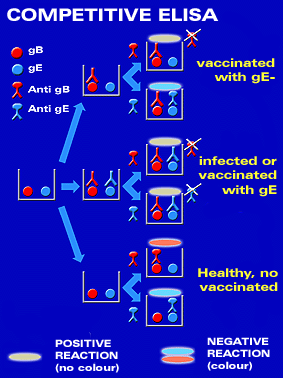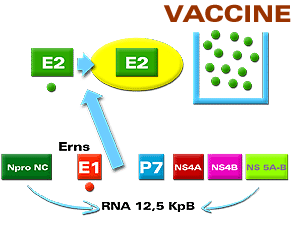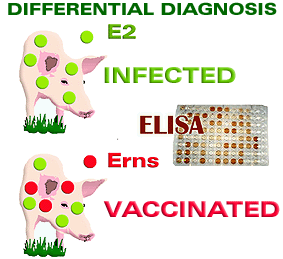|
ATTENUATED VACCINES |
INACTIVATED VACCINES |
| CD 4+ and CD 8+ stimulation |
Mainly CD 4+ |
| CYTOKINES (Interferon) |
Fewer CYTOKINES |
| LESS ANTIGEN |
MORE ANTIGEN |
| LESS STORAGE STABILITY |
MORE STORAGE STABILITY |
| LESS SAFE |
SAFER |
| ADJUVANTS ARE NOT CRITICAL |
ADJUVANTS ARE CRITICAL |
|
New generation vaccines act on the immune system in a different way depending on the type of vaccine. Therefore the sub-unit vaccines or synthetic protein vaccines (inactivated proteins) present a response pattern similar to that of conventional inactivated vaccines, although in general they require more antigens (they are less antigenic) to induce similar responses. The main advantage of these vaccines is that as they are not formed of the entire infectious agent, it is possible to serologically differentiate between vaccinated and sick animals. This feature is even more important in live deleted vaccines or recombinant vaccines. As they are live vaccines, they present a greater immune response than those of inactivated proteins as they express prolonged antigen with similar patterns to those of conventional attenuated vaccines. They can also be differentiated. |
|

Diagram of the competitive ELISA method for the diagnosis of Aujeszky's disease. Vaccinated animals present antibodies only against gB, whilst infected animals have antibodies against gE. |
DNA vaccines, made of a fragment of DNA bound to a promoter, induce a very good immune response at both humoral and cell level. This type of vaccine offers high hopes for the future.

Image of the final development stage of the ELISA technique |
|
| Which problems do we wish to resolve? |
|
New generation vaccines solve some of the problems that can occur with conventional vaccines, including the following: Safety: Sub-unit or synthetic protein vaccines solve the problem of incomplete inactivation which can be seen in conventional inactivated vaccines. These new vaccines do not need to be inactivated as they are only produced by proteins. Deletion or recombinant vaccines solve the problem of possible reversion to virulence. Cold chain: Unlike conventional vaccines, sub-unit or synthetic vaccines do not need to be kept cold. |
|
Differentiation between vaccinated and sick animals: This is probably one of the main advantages of new generation vaccines compared to conventional vaccines. Thus, in the case of Aujeszky’s disease the use of gE negative vaccines (formerly known as gI negative) enables programmes of disease eradication to be carried out. It is possible to identify the status of each animal as vaccinated animals only possess antibodies against the gp II (not against the gE) whilst sick or carrier animals possess antibodies against the gE and gII. Equally, this has been achieved with new sub-unit vaccine against the CSF virus.
|

Cloning process of the E2 protein and expression in baculovirus for the production of the sub-unit vaccine against the CSF virus.
|
|

The ELISA method differentiates vaccinated animals by the sub-unit vaccine (E2). The vaccinated animals only possess antibodies against E2; carrier and/or sick animals possess antibodies against E2 and Erns. |
|
|

